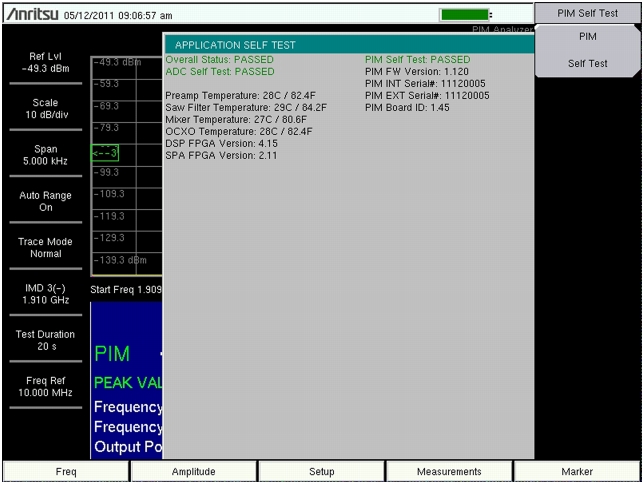The PIM Master, like other high performance instruments, is susceptible to electrostatic discharge (ESD) damage. Coaxial cables and antennas often build up a static charge, which (if allowed to discharge by connecting directly to the PIM Master without discharging the static charge) may damage the PIM Master input circuitry.
Operators should exercise practices outlined within industry standards such as JEDEC‑625 (EIA‑625), MIL‑HDBK‑263, and MIL‑STD‑1686, which pertain to ESD and ESDS devices, equipment, and practices. Because these apply to the PIM Master, Anritsu recommends that any static charges that may be present be dissipated before connecting coaxial cables or antennas to the PIM Master. This may be as simple as temporarily attaching a short or load device to the cable or antenna prior to attaching to the instrument. It is important to remember that the operator may also carry a static charge. Following the practices outlined in the above standards will ensure a safe environment for both personnel and equipment.
Input power for the PIM Master is auto‑sensing for operation with 100 VAC to 240 VAC, 47 Hz to 63 Hz. Confirm that the electrical service at the current location is within these ranges.
|
1.
|
Insert a flathead screwdriver in the slot at the bottom of the fuseholder door and gently rotate to unlatch the door.
|
|
2.
|
Remove the red fuseholder by inserting the flathead screwdriver under the fuseholder edge and gently pushing down. Lift the fuseholder out of the PIM Master.
|
|
3.
|
Insert the new fuse into the PIM Master fuseholder. Replace fuses as required with Anritsu part number: 3‑631‑127 (10 A fast acting fuse, Cooper Bussman AGC‑10‑R, or equivalent).
|
Anritsu handheld instruments that have a touch screen offer additional operator interface options for some features. You can touch a submenu key or a screen feature (such as the button for the Preset State entry in the DTP Parameters window shown in Figure: DTP Parameters Window).
Anritsu Line Sweep Tools can download and open PIM files and DTP files. LST provides a means of reviewing and analyzing traces on a PC.
PIM Master Firmware Update
Please check the Anritsu MW8219A Web page for firmware upgrade procedures. If further assistance is needed, then contact Anritsu at + 1‑800‑ANRITSU (+ 1‑800‑267‑4878).
To determine the current firmware version of your PIM Master, use the following procedure on your Anritsu Handheld instrument, which must be connected to the PIM Master (refer to Figure: PIM Master Connection Diagram):
|
1.
|
|
2.
|
The Application Self Test list box displays the result of testing the current application, which is the PIM analyzer or the DTP analyzer, whichever you are using.
|
3.
|
|
4.
|
The Application Self Test list box provides the results of the PIM Self Test and also displays the firmware version number. Refer to Figure: PIM Self Test Displays Firmware Version.
|
|
For USB storage, Anritsu recommends part number 2000‑1520‑R USB Flash Drive.
|

